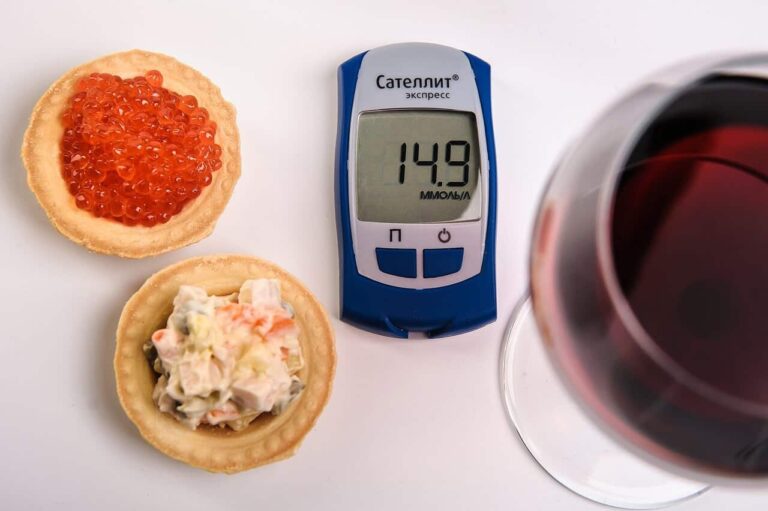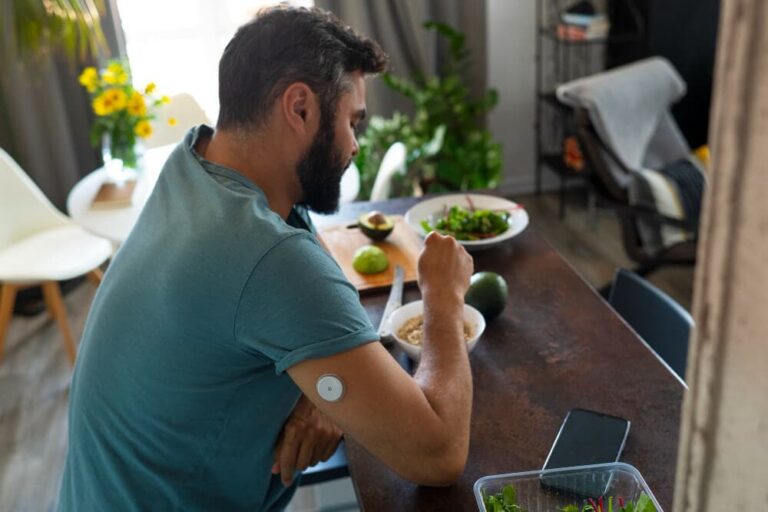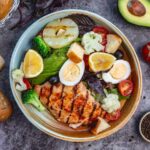Living with Type 1 Diabetes doesn’t mean you’re sentenced to a life of bland, joyless food. Seriously—put that sad, boiled broccoli down for a second. If one more person tells me I should “just eat a salad,” I might just lose it. The myth that T1D means a lifetime of restriction is not only outdated, it’s harmful.
As someone who loves food maybe a little too much (don’t we all?), I’m here to tell you that delicious, satisfying, and even decadent meals can absolutely coexist with Type 1 Diabetes. It’s not about what you can’t eat; it’s about learning how to master what you do eat. It’s about smart adaptation, not deprivation.
This isn’t just a list of three boring meals. This is your comprehensive guide to reclaiming your kitchen, understanding the “why” behind T1D-friendly cooking, and discovering recipes that will make you forget you’re even “eating for diabetes.”
🍽 What Actually Makes a Recipe “T1D-Friendly”?
Let’s clear the air. “T1D-friendly” does not automatically mean low-carb, keto, or sugar-free. While those can be useful tools for some, they aren’t the only way. A truly T1D-friendly recipe is one that is balanced, predictable, and forgiving.
Here’s my personal checklist:
- The Blood Sugar Trinity: The recipe must have a solid combination of Protein, Healthy Fats, and Fiber. These three are the superheroes that slow down the absorption of carbohydrates, helping to prevent those sharp, jagged blood sugar spikes that feel like a ride on the world’s worst rollercoaster.
- Predictable Carb Counts: The carbohydrate sources should be easy to measure and count. This allows for an accurate pre-bolus and reduces the “guess and pray” method of dosing.
- No Sneaky Sugar Bombs: We’re looking for meals without hidden sugars in sauces, dressings, or marinades. A “healthy” salad can quickly become a blood sugar nightmare if it’s drenched in a sugary vinaigrette.
- Flexibility and Adaptability: The recipe should be easy to modify. Some days you need more carbs for energy; other days, you need less. A good recipe allows you to easily scale ingredients up or down without ruining the dish.
🧠 The T1D Smart Plate: Your Blueprint for Balanced Meals
Forget complicated diet rules. The easiest way to build a blood sugar-stable meal is by visualizing your plate. I call it the T1D Smart Plate method.
- ½ of Your Plate: Non-Starchy Vegetables.
- What: Spinach, broccoli, cauliflower, peppers, zucchini, mushrooms, asparagus.
- Why: These are packed with fiber and nutrients but have very few carbs. They fill you up without sending your blood sugar to the moon. They are essentially “free” real estate on your plate.
- ¼ of Your Plate: Lean Protein.
- What: Chicken, fish (like salmon), turkey, tofu, eggs, lentils, beans.
- Why: Protein is the anchor. It slows down digestion significantly, which gives your rapid-acting insulin time to get to work before the carbs hit.
- ¼ of Your Plate: “Smart” Carbs.
- What: Quinoa, sweet potato, brown rice, whole-grain pasta, chickpeas, oats.
- Why: These are complex carbohydrates with a lower glycemic index, meaning they release sugar into your bloodstream more slowly and predictably than their white, refined counterparts.
- A Dash of Healthy Fats:
- What: Avocado, olive oil, nuts, seeds.
- Why: Like protein, fat slows stomach emptying. A little bit of healthy fat can make a huge difference in preventing a post-meal spike.
The Recipes: Your T1D-Friendly Meal Plan for Real Life
Alright, enough theory. Let’s get to the food! Here are some of my tried-and-true recipes for every meal of the day.
(Disclaimer: Carb counts are estimates. Always use your own food scale and carb-counting resources for the most accurate numbers.)
☀️ Breakfasts That Won’t Spike You by 10 AM
Breakfast can be the trickiest meal of the day. Here are options that set you up for success.
1. The “Steady Eddy” Greek Yogurt Parfait
This is my go-to for busy mornings. It’s a perfect blend of protein, fat, and slow-release carbs.
- Carbs: ~25g
- Ingredients: 1 cup full-fat Greek yogurt (the fat is your friend!), ½ cup mixed berries (blueberries, raspberries), 1 tbsp chia seeds, 1 tbsp chopped walnuts.
- Instructions: Layer everything in a jar or bowl. Let the chia seeds sit for 5 minutes to “gel up.”
- T1D Pro-Tip: The combination of fat from the yogurt/nuts and fiber from the chia/berries creates a very gentle blood sugar curve. It’s great for a post-morning-walk meal.
2. The Power Veggie Scramble
When I have a bit more time, this high-protein meal keeps me full and stable for hours.
- Carbs: ~5-10g (mostly from veggies)
- Ingredients: 2-3 eggs, a large handful of spinach, ¼ cup chopped bell peppers, 2 tbsp crumbled feta cheese, 1 tsp olive oil.
- Instructions: Sauté the veggies in olive oil until soft. Whisk the eggs and pour them into the pan. Scramble until cooked, then stir in the spinach and feta at the end.
- T1D Pro-Tip: Pair this with a slice of high-fiber, whole-grain toast (~15g carbs) if you need more energy. The protein from the eggs will buffer the carbs from the toast beautifully.
🥗 Lunches That Prevent the Afternoon Slump
Say goodbye to post-lunch sleepiness with these balanced and easy-to-prep meals.
1. The Ultimate Grilled Chicken Power Bowl
This is meal-prep gold. I make a big batch of the components on Sunday to have for lunches all week.
- Carbs: ~40g
- Ingredients: 4 oz grilled chicken breast (chopped), ½ cup cooked quinoa, ½ cup roasted sweet potato cubes, 1 cup mixed greens, ¼ avocado (sliced), a lemon-tahini dressing (tahini, lemon juice, water, garlic).
- Instructions: Assemble everything in a bowl. Drizzle with the dressing just before eating.
- T1D Pro-Tip: This meal has it all—lean protein, smart carbs, healthy fats, and tons of fiber. It’s a textbook example of a spike-proof meal. Pre-bolus about 15 minutes before eating.
2. Speedy Salmon & Avocado Toast
Don’t knock it ’til you try it! This is a fancy-feeling lunch that takes 5 minutes to make.
- Carbs: ~20g
- Ingredients: 1 slice of sturdy, high-fiber bread (like sourdough or rye), ½ smashed avocado, 2-3 oz smoked salmon, a sprinkle of everything bagel seasoning.
- Instructions: Toast the bread. Spread the smashed avocado on top. Layer on the smoked salmon and sprinkle with seasoning.
- T1D Pro-Tip: The healthy fats from the salmon and avocado make the 20g of carbs from the bread absorb very slowly. It’s surprisingly stable.
🌙 Dinners That Let You Relax
Dinner should be delicious and comforting, not a source of blood sugar anxiety.
1. One-Pan Lemon Herb Salmon & Veggies
Minimal cleanup and maximum flavor. This is a weeknight staple in my house.
- Carbs: ~15g (from veggies)
- Ingredients: 1 salmon fillet, 1 cup broccoli florets, 1 cup chopped asparagus, 1 lemon (sliced), 1 tbsp olive oil, dried herbs (dill, oregano), salt, and pepper.
- Instructions: Preheat oven to 400°F (200°C). Toss veggies with olive oil, salt, and pepper on a baking sheet. Place the salmon fillet in the middle. Season the salmon and top with lemon slices. Bake for 15-20 minutes until the salmon is cooked through.
- T1D Pro-Tip: This meal is naturally low-carb, but if you need more fuel, serve it with a side of ½ cup of brown rice or quinoa (~20-25g carbs).
2. Turkey Meatballs with Zucchini “Zoodles”
All the comfort of spaghetti and meatballs, with a fraction of the carb-counting stress.
- Carbs: ~25g (mostly from tomato sauce and meatballs)
- Ingredients: For meatballs: 1 lb ground turkey, 1 egg, ¼ cup almond flour, spices. For sauce: 1 jar of no-sugar-added marinara sauce. For base: 2-3 spiralized zucchinis.
- Instructions: Mix and form the meatballs, then brown them in a pan. Add the marinara sauce and simmer until cooked through. Serve over lightly sautéed zucchini noodles.
- T1D Pro-Tip: For tricky, high-fat/high-protein meals like this, a “split bolus” or “extended bolus” on an insulin pump can be a game-changer. It delivers part of the insulin upfront and the rest over the next hour or two, matching the slow digestion.
🧁 Snacks & Desserts: Yes, You Can!
Life is too short to skip dessert. The key is smart choices and portion control.
- Quick Snacks: Handful of almonds, an apple with peanut butter, celery sticks with hummus, a hard-boiled egg.
- The “I Need Chocolate” Fix: Two squares of high-quality dark chocolate (70% cacao or higher). It has very little sugar and satisfies the craving.
- T1D-Friendly Chia Seed Pudding:
- Carbs: ~10g
- Ingredients: 2 tbsp chia seeds, ½ cup unsweetened almond milk, a few drops of vanilla extract, a pinch of cinnamon, and a keto-friendly sweetener like stevia or monk fruit.
- Instructions: Mix everything in a jar and let it sit in the fridge for at least 2 hours (or overnight). Top with a few berries before serving.
Final Thoughts: Food is Fuel and Joy, Not Your Enemy
I’m not a registered dietitian, and this isn’t medical advice. This is a collection of lessons learned from thousands of meals, countless finger pricks, and a relentless passion for good food.
Living with Type 1 Diabetes forces you to become a student of nutrition in a way most people never will. It teaches you to listen to your body, respect the science of food, and find creative ways to enjoy the things you love. It means we might bring a calculator and an insulin pen to the dinner table, but we absolutely still deserve a seat.
So go ahead. Try a new recipe. Experiment. Take notes. And most importantly, savor every delicious, well-bolused bite.











